Magnetism and electricity: Identify, describe and apply principles of magnetism
Unit 2: The Earth’s magnetic field
Leigh Kleynhans
Unit outcomes
By the end of this unit you will be able to:
- Identify and describe the Earth’s magnetic field.
- Describe magnetic declination.
- Describe the working of a compass.
- Apply magnetic phenomena by induction of the Earth’s magnetic field and refer to iron and steel used in building construction.
What you should know
Before you start this unit, make sure you:
- Understand the principles of magnets and magnetic fields, as covered in Subject outcome 4.1, Unit 1.
Introduction
The Earth behaves like a giant bar magnet and as such there is a magnetic field present around it. The Earth’s magnetic field is thought to be caused by flowing liquid metals in the outer core of the planet which causes electric currents and a magnetic field.
The Earth’s magnetic field and magnetic declination
In Figure 1 you can see a representation of the Earth’s magnetic field, which is very similar to the magnetic field of a giant bar magnet shown in Figure 2. The Earth has two , a north and a south pole just like a bar magnet.
In addition to the magnetic poles the Earth also has two . The two geographic poles are the points on the Earth’s surface where the line of the Earth’s axis of rotation meets the surface. To visualise this, you could take any round fruit (lemon, orange, etc.) and stick a pencil through the middle so it comes out the other side. Turn the pencil, the pencil is the axis of rotation and the geographic poles are where the pencil enters and exits the fruit. We call the geographic north pole .
The Earth’s magnetic field has been measured very precisely and scientists have found that the position of the magnetic poles do not correspond exactly to the geographic poles.
So, the Earth has two north poles and two south poles: two geographic poles and two magnetic poles.
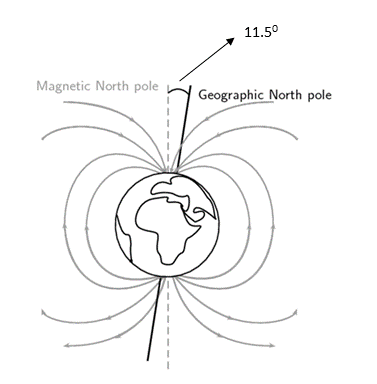
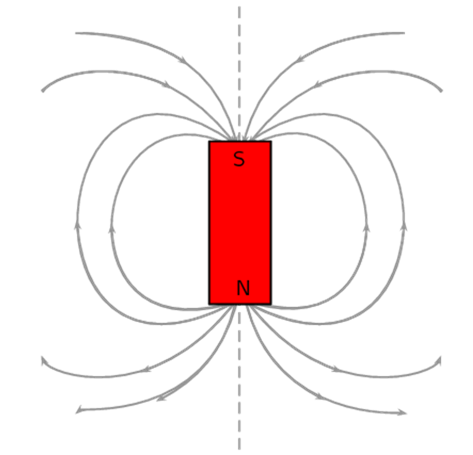
In Figure 1 you can see that the direction of magnetic north and true north are not identical. The geographic north pole is about [latex]\scriptsize {{11.5}^{\text{o}}}[/latex] away from the direction of the magnetic north pole (which is where a compass will point). This difference is referred to as . However, the magnetic poles shift slightly all the time.
Another interesting thing to note is that if we think of the Earth as a big bar magnet, and we know that magnetic field lines always point from north to south, then the tells us that what we call the magnetic north pole is actually the south pole of the ‘bar magnet’ within the earth!
Activity 2.1: Investigate the Earth’s magnetic poles with a compass simulation
Time required: 5 minutes
What you need:
- an internet connection
What to do:
- Open the PhET simulation. [link: https://phet.colorado.edu/sims/cheerpj/faraday/latest/faraday.html?simulation=magnet-and-compass]
- Tick the checkbox for ‘Show planet Earth’.
- Move the compass and note the direction of the magnetic field at several points.
What did you find?
The compass shows that the direction of the magnetic field around the Earth is outwards at the geographic south pole and inwards at the geographic north pole.
How a compass works
A compass is an instrument that is used to find the direction of a magnetic field. A compass consists of a small metal needle which is magnetised itself and which is free to turn in any direction. The point of the needle is the north pole of the magnet. Therefore, when in the presence of a magnetic field, the needle lines up in the same direction as the field.
Compasses are mainly used in navigation to find direction on the Earth. This works because the Earth’s magnetic field is similar to that of a bar magnet (see Figures 1 and 2). The compass needle (a north pole) aligns with the Earth’s magnetic field direction and points towards the south of the Earth’s magnetic field. This direction is referred to as north (N). Once you know where north is, you can figure out any other direction.

Exercise 2.1
- What causes the earth to have a magnetic field?
- Why is the earth’s geographic north not the same as its magnetic north?
- Why does a compass needle point towards the earth’s magnetic north pole?
The full solutions are at the end of the unit.
The importance of the magnetic field to life on Earth
The Earth’s magnetic field is very important for humans and other animals on Earth because it protects us from being bombarded by high energy charged particles which are emitted by the Sun. The stream of charged particles (mainly positively charged protons and negatively charged electrons) coming from the sun is called the . When these particles come close to the Earth, they are deflected by the Earth’s magnetic field and cannot shower down to the surface where they can harm living organisms. Astronauts in space are at risk of being exposed to from the solar wind because they are outside the zones where the charged particles are trapped.
The region above Earth’s atmosphere in which charged particles are affected by the Earth’s magnetic field is called the . Relatively often, in addition to the usual solar wind, the sun may eject a large bubble of material (protons and electrons) with its own magnetic field. Sometimes these bubbles travel towards the Earth where their magnetic fields can join with Earth’s magnetic field. When this happens a huge amount of energy is released into the Earth’s magnetosphere, causing a . These storms cause rapid changes in the Earth’s magnetosphere which in turn may affect electric and magnetic systems on the Earth such as power grids, cell phone networks, and other electronic systems.
Other effects caused by the Earth’s magnetic field are the spectacular northern and southern lights, which are also called the and the respectively. When charged particles from the solar wind reach the Earth’s magnetosphere, they spiral along the magnetic field lines towards the north and south poles. If they collide with particles in the Earth’s atmosphere, they can cause red or green lights which stretch across a large part of the sky and this is called the aurora.
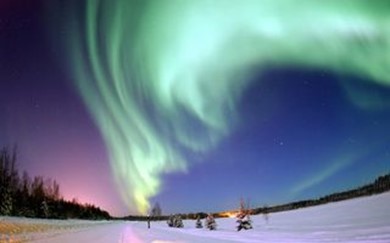
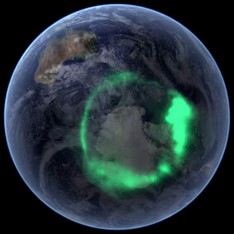
As this only happens close to the north and south poles, we cannot see the aurorae from South Africa. However, people living in the high northern latitudes in Canada, Sweden, and Finland, for example, often see the northern lights.
Some animals can detect magnetic fields, which helps them orientate themselves and navigate. Animals that can do this include pigeons, bees, monarch butterflies, sea turtles and certain fish.
Iron can be easily magnetised when placed in a magnetic field. This property needs to be considered when it is used in building construction. As steel is more difficult to magnetise, it is more often used for building construction.
Note
Watch the Fuse School Video on the Earth’s magnetic field and compasses, which summarises the concepts covered in this unit (Duration: 3.42).
Summary
In this unit you have learnt the following:
- The Earth has a magnetic field.
- A compass can be used to find the magnetic north pole and help us find our direction.
- The magnetic north pole does not correspond precisely with the geographic north pole – this difference is called magnetic declination.
- The Earth’s magnetic field protects us from being bombarded by high energy charged particles which are emitted by the sun.
- The aurorae are effects of the Earth’s magnetic field.
Unit 2: Assessment
Suggested time to complete: 15 minutes
- Draw a diagram showing the magnetic field around the Earth, and indicate the poles of a bar magnet within the Earth.
- Explain the difference between the geographical north pole and the magnetic north pole of the Earth.
- Explain how a compass works.
- Explain why the Earth’s magnetic field has a protective effect for the planet.
- Describe the effects of a geomagnetic storm in the magnetosphere.
The full solutions are at the end of the unit.
Unit 2: Solutions
Exercise 2.1
- The Earth’s magnetic field is thought to be caused by flowing liquid metals in the outer core of the planet which causes electric currents and a magnetic field.
- This is because of the declination (tilt of the axis) of the earth. The northmost point of the earth (the geographic north pole) is about [latex]\scriptsize {{11.5}^{\text{o}}}[/latex] away from the direction of the magnetic north pole.
- The compass needle is a north pole of a magnet, so it aligns with the Earth’s magnetic field direction and points towards the south of the Earth’s magnetic field.
Unit 2: Assessment
- .
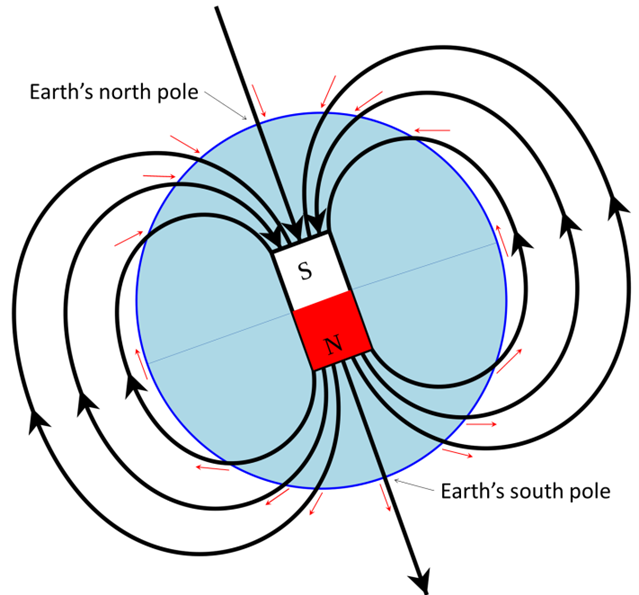
- The geographic north pole is the point on the Earth that is furthest north or where the line of axis of rotation meets the surface. Whereas the magnetic north pole is where the magnetic field lines of the Earth’s magnetic field converge.
- A compass has a needle made of a magnet. The north pole of the magnet is the point of the needle. It will therefore be attracted towards the south pole of the Earth’s magnetic field. This direction is called north (N), and all other directions can then be determined once north is known.
- The Earth is continually bombarded by streams of charged particles released from the sun which can damage living organisms. These particles are deflected by the Earth’s magnetic field.
- Geomagnetic storms cause rapid changes in the magnetosphere which can affect magnetic and electric systems like power grids, cell phone networks and electronics.
Media Attributions
- img01_Figure1 © Siyavula is licensed under a CC BY-NC-ND (Attribution NonCommercial NoDerivatives) license
- img02_Figure2 © Siyavula is licensed under a CC BY-NC-ND (Attribution NonCommercial NoDerivatives) license
- img03_Figure3 © Siyavula is licensed under a CC BY-NC-ND (Attribution NonCommercial NoDerivatives) license
- img04_Figure4 © Siyavula is licensed under a CC BY-NC-ND (Attribution NonCommercial NoDerivatives) license
- img05_Figure5 © Siyavula is licensed under a CC BY-NC-ND (Attribution NonCommercial NoDerivatives) license
- QR_Code_PSL2SO41U2_1
- img06_AssessmentQ1answer © Siyavula is licensed under a CC BY-NC-ND (Attribution NonCommercial NoDerivatives) license
the points on the Earth where the magnetic field lines enter or leave the Earth
the geographic location of the northernmost and southernmost points on Earth where the line of the axis of rotation meets the surface
the northernmost point on the earth
the angle between magnetic north and geographic north
an instrument that uses a magnet to determine direction
stream of charged particles that come from the sun
dangerous levels of energy from charged particles
the area above the Earth’s atmosphere that is affected by its magnetic field
a temporary disturbance of the Earth's magnetosphere caused by the magnetic field from a solar wind interacting with the Earth's magnetic field
green or red lights that stream across the sky near the north pole, caused by charged particles from a solar wind that spiral along the Earth’s magnetic field lines and collide with the particles in the Earth’s atmosphere
green or red lights that stream across the sky near the south pole, caused by charged particles from a solar wind that spiral along the Earth’s magnetic field lines and collide with the particles in the Earth’s atmosphere

